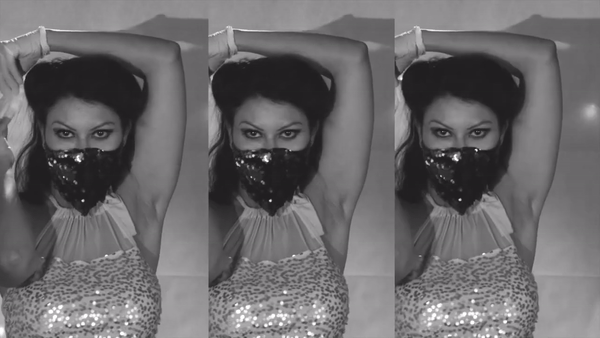Words by: Erkan Affan
Images and videos provided by HaRaKa Platform
This article is part of the “Ya Leil Ya Eyein” issue
Adham Hafez is a powerhouse of contemporary artistry from the region. Engaged in theory and practice around political science, performance history, choreography, and climate change, Adham is a scholar, artist and theorist working in Cairo, Berlin, and New York. His interdisciplinary approach led to the formation of the HaRaKa Platform, Egypt’s first structure dedicated to research and theory in the fields of performance studies, choreography, and theatre.
Adham’s performance piece titled “Cairo KitKat Club” is a live, experimental, digital performance by the HaRaKa Platform, which explores the cabaret scene historically located in the Kit Kat neighborhood of Egypt’s capital. Due to COVID19 and forced quarantining, “Cairo KitKat Club” premiered as window projection, on Goethe Institute New York’s building. The performance is an outgrowth of a HaRaKa collective research project on the Suez Canal, the piece utilizes a variety of methodologies and mediums of presentation in the understanding of art history from Arab and postcolonial practices, Adham’s work both in “Cairo KitKat Club” and beyond centers the exchange of knowledge in a manner that educates, informs, and advises its audience. Below, we delve into his practice and talk more specifically about some of the intricacies in the “Cairo KitKat Club” piece too.
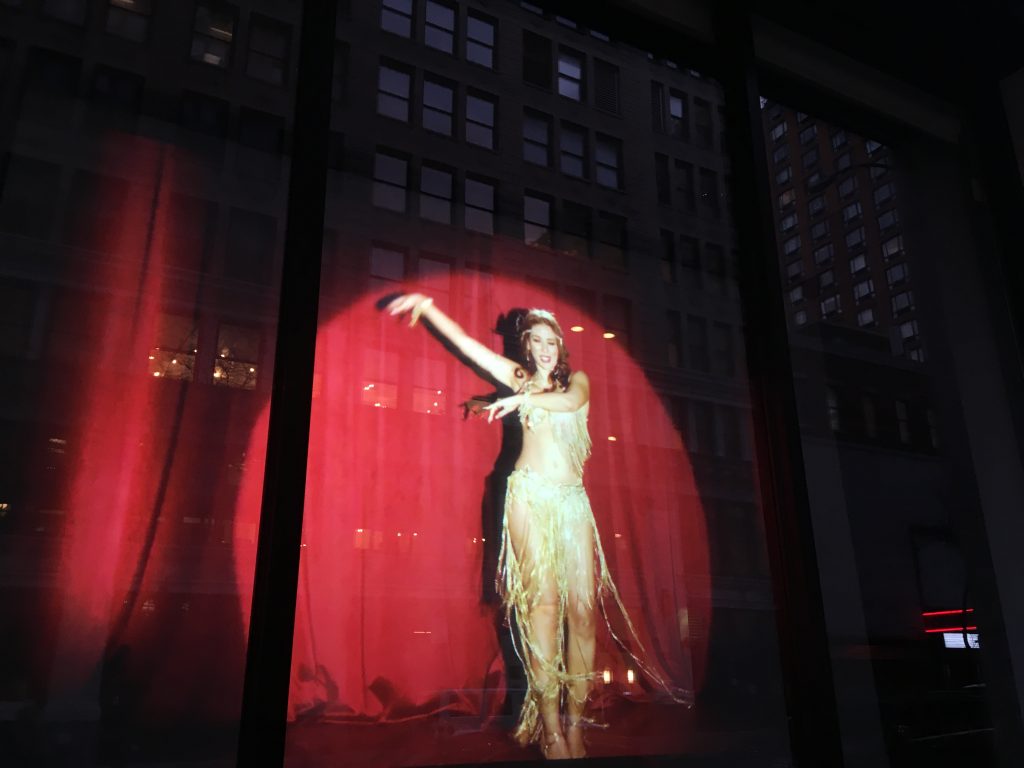
“Cairo KitKat Club” premiered as window projection with dancer Amie Sultan, on Goethe Institute New York’s building, 2020
How do you identify yourself and your practice?
I am an artist, theorist, and curator. My work has always moved back and forth between practice and reflecting. I was trained both as a musician and as a dancer, and that’s why most of my productions have elements of movement, voice, and sound, rather than just ‘dance’ in a limiting understanding.
How do you bring your academic and non-academic practices together? Would you identify your work as interdisciplinary, and if so, how?
A lot of the work I develop happens through a long process of research. I was driven to work within academia because of my research-based artistic practice. Through my collective, HaRaKa Platform, we have been able to bridge the gap between theory and practice by curating, publishing, teaching, lecturing, and organising conferences and symposia. This engagement with theoretical work defines what we end up staging of course, rooting movement and performance in a long investigation, archival work, and writing. Equally, the academic or research-based work is shaped by an embodied practice of dance, song, music, and theatre, which has been truly special for my theoretical work (be it teaching, lecturing, or publishing). I speak from a very embodied place.
What were the motivations behind creating the “To Catch a Terrorist” (2018) piece with La Mama Theatre in New York? How did you find the process of artistic collaboration when creating a piece of work that brings together painting, choreography, coding, and performance?
I had been living in New York City for several years already, and in 2016, when Donald Trump became president of the United States, I started receiving apologies from liberal democratic friends of mine. Theres were friends who work in the field of culture in New York, who were shocked at the open display of racism, specifically the Muslim Ban. I was surprised that all my friends had no idea of the racism that Arab, Muslim, or Middle Eastern folks go through in the US, before Trump. That many of these cultural workers had no idea that it was not possible to be both Muslim and a US citizen, until the 1940s. That it was in fact illegal to be a US Muslim! I decided to create “To Catch A Terrorist” to place on stage a genealogy of racism and anti-Muslim, anti-Arab hate, that is institutionalized in many aspects of living in the US, from Disney to the War on Terror.
“The process then developed quite naturally. I knew I wanted to investigate a lot of text in such a short duration. Adam Kucharski came up with the idea of running the text through language-parsing code to see the ‘essence’ of the texts and their structure. It was a shock to see that most of the legal texts we used (about 60 years of American jurisprudence) were mostly about constructing a notion of ‘Whiteness’ rather than strictly anti-Arab or anti-Muslim. We invited visual artist and painter Manar Abdelmaaboud to start depicting stereotypes from cinema to Disney cartoons, and the work ended up looking like a re-staging of a court scene. We worked with the stellar choreographer and dancer Irene Hultman to build the choreographic/ forensic score. We wanted to bring our research to the stage, rather than finish it, and create a piece.

Lamia Gouda, performing in Cairo KitKat Club. HaRaKa Platform 2020
In “Extra-Territorial Ministry of Arab Culture” (2017), you focus on the confusion that comes with oscillating between reality and fiction to assess the future of cultural institutions, and the making of urban realities and cities. How does the environment in which the work is presented influence such explorations? (e.g. Cite de la Culture in Tunisia, KinoKultura in Skopje, and the municipal building of Napoli).
I believe that the work we create as artists always sits within a very particular context. Any theatre building is a specific building. Any gallery is the same. However, we tend to normalize buildings that are meant for artistic presentations, which then produces a category known as ‘site-specific art,’ whilst I think that all art is site-specific.
As for ETMAC (the Extra Territorial Ministry of Arab Culture), I created this work with Adam Kucharski, who is an urbanist and anthropologist. We did not start by thinking of creating a fictional work. We started by creating a joint lecture presentation about the state of arts and culture in the Arab region, from the perspective of funding and economy. The idea arose very quickly to build a theatre work; a performance that proposes and performs ‘best practices’ and scenarios for hope ends up creating more dark humour and institutional critiques than anything else.
Together with Adam, and later with the rest of the HaRaKa Platform, Mona Gamil and Lamia Gouda, we continued to perform and tour it. It takes on different meanings as it goes to places like Cite de la Culture in Tunisia and then to the historic Napoli Municipal Hall. In Tunisia, we had a lot of people come up afterward and ask for funding, believing that the work is not fiction. We had hired a professional translator who translated live during the performance, which already derails theatre into the aesthetic of a conference and makes the fiction closer to reality. It is these small switches in the dramaturgy that I find very important in playing with the work.
Four years later, we decided to do the opposite, and take the fiction towards becoming reality. We founded a company called “Wizara” (playing on the “Ministry” in ETMAC), the first artists-for-artists blockchain-based platform that supports, commissions, curates, and produces work with artists from the region and beyond. In a way, the poetry and humour of ETMAC gave birth to an actual company, which is Wizara.
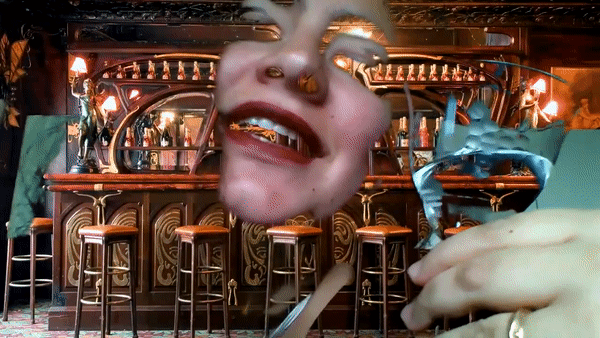
Opera singer Ohoude Khadr reenacting famous cabaret personas from the late 19th and early 20th century. Cairo KitKat Club, production of HaRaKa Platform- 2020
Explorations of reality vis-à-vis fiction are also present in your earlier work titled “AA – Artists Anonymous” (2016), in which you incorporate both testimonials from Arab artists from the 1930s through the onset of the Arab Spring and fictitious documents to uncover potential intersections between emotion and politics. What is the intention of such an exploration?
Shuttling between fiction and reality allows for many interesting things to happen. For one, you can critique a fictitious moment of history, or push a current event into the far future and work with it there, and it eases people into allowing themselves to be critical, not worrying about the present moment. The ease that fiction gives us, especially futurist narratives, is that we can suspend a lot of our judgments, and get to a creative collective working place together – as audiences and artists. Hope can be found again.
Tell me a bit more about your collective, HaRaKa? What does “performance archaeology” entail?
HaRaKa Platform is a collective formed in 2006, though its work has existed since 2003/2004. The collective is a small group of artists, theorists, and specialists in fields that are not necessarily artistic, such as political science and urbanism. When we started, we were interested in filling in gaps in research and documentation on the contemporary dance and performance scenes in the region. We began by running research projects, archival work, workshops on dance and camera, and moved quickly into creating complex projects that bring together theory and practice. Since then, we have been creating works collaboratively and internationally. HaRaKa today is directed by Lamia Gouda, Mona Gamil, Adam Kucharski, and myself, and we develop and produce our work together.
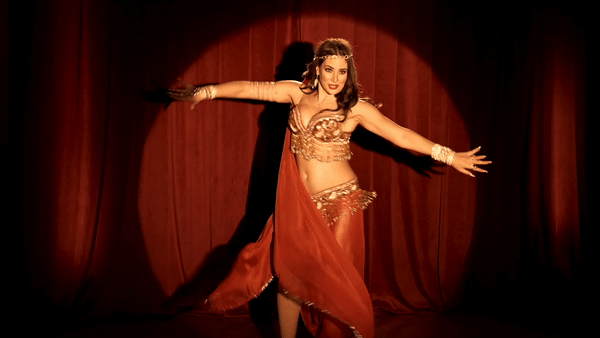
Amie Sultan performing in Cairo KitKat Club, production of HaRaKa Platform- 2020
Can you talk a bit more about the work that you and Ismail Fayed did on the publication series “Cairography”?
“Ismail Fayed and I always wanted to start a publication. HaRaKa had been translating and publishing art-related theoretical work, and we started the project, “Cairography,” in 2014 with the aim of encouraging research and publishing both in Arabic and English. The publication continues to unfold through a crucial partnership with the Brussels-based association, Sarma, directed by Myriam Van Imschoot, and Cairography Publication is now the labor of us three, myself, Myriam and Ismail. Together with Sarma, we think of publishing also as a collaborative artistic labour.
Fastforwarding a bit to HaRaKa’s release of the digital performance piece, “Cairo KitKat Club” — how did the idea develop for this piece? What first drew you to focus on and archive Cairo’s KitKat Club?
We were actually creating a performance about the history of the Suez Canal in 2019, and stumbled upon a lot of early 20th century documents of Egypt. And, someone had told us that we were already using elements and tools of “cabaret” in our performance work. That’s where it came to us, the idea of doing a full-on cabaret work, and the story of KitKat was too good to not be the first cabaret work we created.
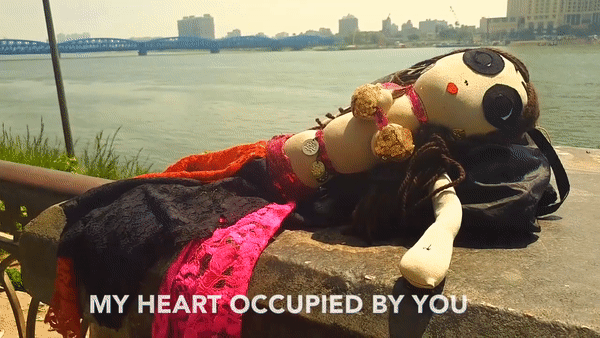
Cairo KitKat Club, production of HaRaKa Platform- 2020
You were able to access declassified MI5 files, oral histories, and intergenerational chronicles of clubbing in an international context while developing your “Cairo KitKat Club” piece. Can you say more about the process of gathering and analyzing different forms of knowledge and data? Was there any form or guide that held precedence?
Luckily, because of our Suez project, we had to travel to many places. One of them was London, where we found a lot of documents at the National Archives that were recently declassified. When you find one thread, it leads to another. You find one story, it opens another file, another name, another picture. It’s the magic of archival work and of research, which becomes more magical when bringing it to the stage as a performance.
We also held a number of conversations and interviews, and our artists went and recorded with people living around the clubs and cabarets. Between oral narratives, personal histories, archival material, fiction, and cinematic documentation, the project found itself in a rich pool of information. We could have created hours and hours of performance, and maybe we will!
The piece mentions that “urban development created the density and anonymity necessary for transgressive performances like cabaret to take hold and to thrive.” Can you elaborate on this in the Cairo context?
This is more the work of Adam Kucharski, the aforementioned urbanist and anthropologist. He is capable of reading space and its politics from another perspective, the way I can read it from a choreographic and a performative aspect. His theory is that you cannot have the anonymity and density required by cabaret life, nightlife, and theatre life in general without the reinvention of the city as a dense metropolis, the way Cairo was and still is. Cabaret would not have been able to thrive and become an international phenomenon in smaller provincial contexts; it needed the flow of people, new streets, bars, new housing developments, and entire neighborhoods rising for something as radical as these clandestine performances to emerge. With a whole history of migration, of course, many European and Levantine immigrants settled in Cairo precisely because of Cairo’s latest developments. Many of them contributed to cinema, theatre, dance, and cabaret history eventually.
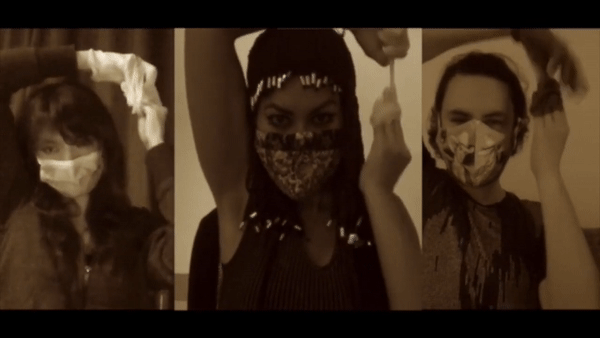
A Covid-Striptease with Mona Gamil, Lamia Gouda, Adham Hafez, performing at ‘Cairo KitKat Club, production of HaRaKa Platform- 2020.
Following on this, would you say that such conditions of density and anonymity still apply in the contemporary context (both in Cairo and in other localities)?
Density and anonymity still apply in the context of Cairo and other cities like Berlin and New York. For a thriving club culture or cabaret culture to continue, you need the influx of people and audience. You need the locals that go there frequently, but also ones who discover it for the first time and make their own. There is desire, finance, love, and real estate, all intersecting in complicated ways. Our cities are very complex creatures.
You collectively explore the notion that Cairo’s cabaret scene “borrowed from Paris, Berlin and New York” whilst emphasising its creation of entirely new idiosyncratic and indigenous artistic forms. Can you talk a bit more about these new forms that were created in the Cairo context? What made them so distinct?
In addition to the diversity of choreography that took place there, from belly-dancing (or Egyptian dance) to classical ballet to tango, there were a number of forms that were very specific to that moment in time. There was the comic monologue, with stars like Shukuku or Thoraya Helmy, and magic acts. There were micro-dramas, or short plays, that would narrate just one thing or story, or were about one ‘morale’ rather than narrative-based.
Every city and performance culture has its own very specific stories, and Cairo is no different. Because of Cairo’s geopolitical position, political history, and relation to Europe, the city became a portal between Europe, the U.S., and the rest of the Arab and African worlds. You end up with Josephine Baker and Cecile B. DeMille performing in Cairo, Samia Gamal working with the nightlife scene in New York, and Hekmat Fahmy dancing in Europe.
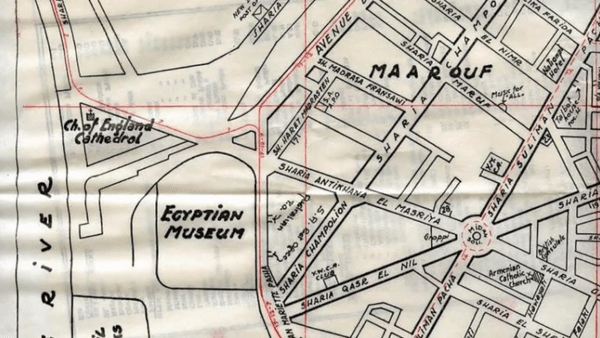
Archival map of Downtown Cairo, seen during a lecture-performance by American urbanist Adam Kucharski during ‘Cairo KitKat Club’, production of HaRaKa Platform- 2020
How have historical narratives of the pre-existing physical architecture in the neighbouring area where the club was located influenced its development?
Sadly, the KitKat does not physically exist anymore in Cairo. The house (or rather a palace) of the founder still exists and is now the Swiss Club of Cairo. The neighborhood is still called KitKat and many people remember that the famous cabaret once stood there by the Nile. Others only know of the subway station being built there, or the mosque that stands on the square now. As for the rest of Downtown Cairo, many of the buildings, bars, and cafes from the late 19th/early 20th century are still there.
It is both beautiful and heartbreaking. You walk around this former glory and feel privileged that you grew up in such a dense performance history that is influenced by multiple references, as well as it being very influential itself. But then it is very saddening to see it mostly gone, to see buildings being torn down or repurposed. The next generation will not even know what these buildings were if we do not protect the buildings today. And if we cannot, then at least we must try to protect and tell these stories. That’s one of the reasons we created Cairo KitKat Club, as an act of resistance against urban decay and the erasure of the rich contribution to performance history that Egypt played a great role in.
Having already been exhibited as part of international programmes such as Shubbak Festival in London, are there particular contexts, environments, or programmes where you hope Cairo KitKat Club will be featured?
We would love to see the show live in a cabaret, be it a dusty old building or a rising new one. It could be in a city like Cairo or Beirut, or one of the cities that Cairo was in dialogue with, such as Berlin, Paris, London, and New York.
I am very grateful that we managed to create this work in the middle of a global lockdown, but I want to insist on presence and physicality, intimacy and proximity, and public conviviality. These are all also forms of resistance.
Note: Cairo KitKat Club is not open to the public currently and available only through organizing viewing session with HaRaKa Platform

